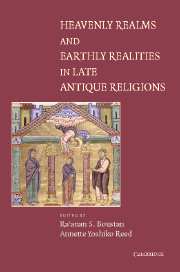Book contents
- Frontmatter
- Contents
- Preface
- List of Contributors
- Introduction: “In Heaven as It Is on Earth”
- PART ONE BETWEEN EARTH AND HEAVEN
- 1 The Bridge and the Ladder: Narrow Passages in Late Antique Visions
- 2 “Heavenly Steps”: Manilius 4.119–121 and Its Background
- 3 Heavenly Ascent, Angelic Descent, and the Transmission of Knowledge in 1 Enoch 6–16
- 4 “Connecting Heaven and Earth”: The Function of the Hymns in Revelation 4–5
- 5 Working Overtime in the Afterlife; or, No Rest for the Virtuous
- PART TWO INSTITUTIONALIZING HEAVEN
- PART THREE TRADITION AND INNOVATION
- Select Bibliography
- Index
4 - “Connecting Heaven and Earth”: The Function of the Hymns in Revelation 4–5
Published online by Cambridge University Press: 14 July 2009
- Frontmatter
- Contents
- Preface
- List of Contributors
- Introduction: “In Heaven as It Is on Earth”
- PART ONE BETWEEN EARTH AND HEAVEN
- 1 The Bridge and the Ladder: Narrow Passages in Late Antique Visions
- 2 “Heavenly Steps”: Manilius 4.119–121 and Its Background
- 3 Heavenly Ascent, Angelic Descent, and the Transmission of Knowledge in 1 Enoch 6–16
- 4 “Connecting Heaven and Earth”: The Function of the Hymns in Revelation 4–5
- 5 Working Overtime in the Afterlife; or, No Rest for the Virtuous
- PART TWO INSTITUTIONALIZING HEAVEN
- PART THREE TRADITION AND INNOVATION
- Select Bibliography
- Index
Summary
Although references to heavenly liturgy abound in late antique literature, we rarely find this liturgy described in full detail. One important exception is Revelation 4–5, the most extended body of literature of this kind. The five hymns in these chapters (4:8, 4:11, 5:9–10, 5:12, and 5:13) are closely interlinked; they are first sung by heavenly beings and then intoned by the entire earthly creation. As such, they present a frame of reference for the readers and hearers of Revelation, drawing attention to a full heavenly worship containing several parts. Moreover, the heavenly liturgy plays a dominating and definitive role in Revelation. Not only do these hymns stand at the beginning of the vision section, functioning as an impressive portal into the rest of the apocalypse, but they set the tone for the following chapters (6–21), which allow its readers and hearers to glimpse further into heavenly realities.
Because the hymns are closely related to their literary context, it is clear that they were not composed to describe only heavenly worship. Hence, we must further ask these questions: What is the nature of the hymns, and how should we understand their content and their function within John of Patmos' broader message? How are they connected, and what is their background? How does John relate them to the earthly struggle between the faithful community and the powers, among the gods, between the elected people and their enemies, between the divine and profane forces, between Good and Evil?
- Type
- Chapter
- Information
- Publisher: Cambridge University PressPrint publication year: 2004
- 2
- Cited by



